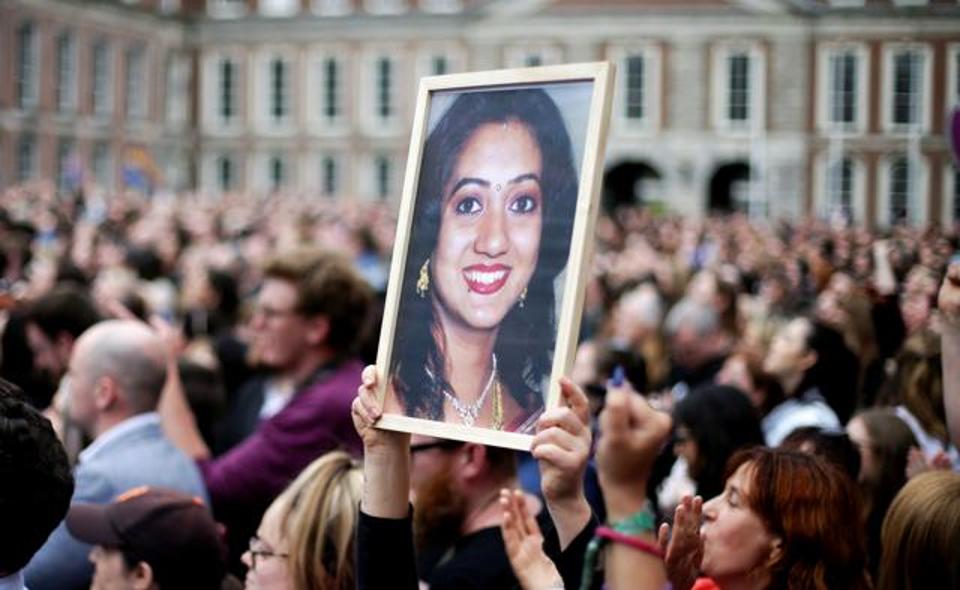By Socialist Party reporters
The referendum to scrap the ban on abortion was easily passed with 66.4% to 33.6% on a turnout of over 64%, the highest ever for a referendum in Ireland. The result was nearly an exact reversal of the 1983 vote which imposed the ban, except nearly a million more voted this time. As the government, in line with proposals from the Citizen’s Assembly, had said that they intended to legislate for abortion up to 12 weeks on request if Yes won, this can only be interpreted as a very strong pro-choice vote.
Establishment politicians and the media are desperately trying to re-write the real history of the radical struggle that brought about this change because they fear that people will take confidence from it and realise they can organise powerful mass struggles on all the key issues and and against the whole capitalist system itself, which is founded on the principle of inequality. Socialist Party member and Solidarity TD Ruth Coppinger, a key leading force in this struggle, was also consciously excluded from the national media during the campaign itself. So this article, written by members of the Socialist Party attempts to put the record straight. Socialist Party, alongside other activists, played a vital role in ROSA’s national Yes campaign- #Time4Choice- which had a big impact. We were also part of the broad Together4Yes group.
After 35 years, the sentiment to get rid of the 8th Amendment to the constitution was universal. There wasn’t a fundamental contrast between cities and country, as attitudes had also changed in smaller towns and rural areas. Only one constituency voted no whereas in 1983 they all said yes to the ban, except one. Even Connaught/Ulster, traditionally the more conservative province, was cut-and-dried at 59% to 41%.
The yes vote was very strong in urban areas. Most cities had a yes vote of just below or just above 70%. Dublin had nine in the top ten yes constituencies and Wicklow at 74.26% was the other. The overall yes percentage in Dublin was 75.5%. In Stoneybatter, which is made up of working class communities, as well as a new younger demographic moving into the area, the vote was reportedly 92%.
The vote was very high among the middle class and working class. The figures point to it being higher in the former, though in the campaign it was clear that the depth of feeling on the issue was strongest in the working class, with working-class women being the beating heart of the revolt.
Young women – the beating heart
65% of men and 70% of women who voted, voted yes. Overall, 87% of under 25-year-olds who voted, voted yes, and 90% of young women. Young women have been the driving force behind this movement over the last years and particularly in the culmination of the referendum campaign itself. The number of young women who voted in the referendum compared to the last general election in 2016 increased by a massive 94%. Trans young people and school students were also to the forefront and GCN estimated that 91% of the LGBTQ community who voted, voted yes.
This change has been building over years and the formal campaign itself was long, spread over two months, starting in late March when the Government formally signed the order establishing the details of the referendum.
The start was signalled with disgusting misogynistic posters from the No campaign with pictures of foetuses and headlines that screamed, “Licence to kill? Vote No”, “Don’t Choose Death – Vote No”, “In England 1 in 5 babies are aborted – Vote No”, “If Killing an Unborn Baby at Six Months Bothers You, then Vote No”.
However, by 25 May people had decisively rejected the extremely well-funded No campaign (which included resources and ads linked to the religious right in the US), in a vote that has sent ripples around the world.
Vox, the US news and opinion site, said, “Pro-repeal sentiment was especially strong among young and urban voters, suggesting a new left-leaning and secular majority had supplanted the more conservative Catholic older generations.”
Left-leaning and secular
This result reflected changes that have been ongoing in Ireland over recent decades. In fact, the original 1983 amendment to the constitution was, in a sense, a political stroke involving the clerical right and conservative politicians with the support of the church because they feared that Ireland was changing in terms of social attitudes, so they rushed to get a ban in before it was too late.
Along with the world, Irish society has changed enormously since then, but official Irish society and the political establishment refused to reflect this change with significant changes in the constitution and legislation. The extent of the change that has now been forced on the political establishment is indicated by the fact that just five years ago, the Protection of Life During Pregnancy Act came into law and this included a provision that anyone procuring an abortion could be imprisoned for 14 years!
In the many years after 1983, the existence of the 8th Amendment ban and the domination of politics by the conservative parties (including when Labour became part of the establishment in the 1990s), meant many reluctantly felt they had to accept this latest hypocritical “Irish solution to an Irish problem”; that is, that for the foreseeable future abortion would not be allowed in Ireland on the basis that people could travel to Britain to avail of abortion facilities there.
But 1992 saw the X Case, in which a minor who was raped was initially prevented from travelling to Britain for an abortion but was subsequently allowed to, after the Supreme Court decided that the 8th Amendment allowed abortion where there was a threat to the life of the mother. However, the ban remained fundamentally intact.
The attitude of young women growing up in the noughties, with the backdrop of the Celtic Tiger, was not to accept the status quo. That was not the mood or attitude of young women growing up in the noughties, with the backdrop of the Celtic Tiger. Then there was a growing demand for women’s rights and equality and for a modern secular state, and that meant bodily autonomy and abortion rights. Since then, young women have been a key dynamic pushing Irish society forward.
Savita – turning point 1
Then the death of Savita Halappanavar in October 2012 in Galway University Hospital was an extremely important turning point. In huge pain, Savita was found to be miscarrying and she asked for an abortion but this was refused. The ruling in the X Case specifically sated that abortion could be only allowed where there was “a real and substantial risk” to the life of a woman.
Apart from basically saying that a woman’s health doesn’t matter, this legal position meant that in the time taken to judge or decide that there is a “real and substantial risk” to life, a condition could become terminal and therefore it could be too late. The bottom line was that the ruling in the X Case offered no guarantee to women, and Savita would only have definitely been saved if she had been given an abortion when she asked for one.
There was huge anger at Savita’s death and tens of thousands of young people, particularly young women, mobilised to demand change. The general position of many longstanding and prominent campaigners in the pro-choice and abortion rights movement at the time was to demand that the ruling in the X Case should be legislated for, to help formalise and clarify what was permitted within the 8th Amendment.
The Socialist Party, particularly through councillor Ruth Coppinger, took a different position saying that immediate repeal of the 8th Amendment was necessary to be quickly followed by legislation that provided for abortion rights. These ideas got a very strong response from the young women mobilised into action by Savita’s death. Leading activists in the Socialist Party and others established ROSA as a socialist feminist platform in the developing movement, of course with a particular focus on repeal and abortion.
In response to Savita’s death and the political crisis it created, the Fine Gael and Labour Government brought in the Protection of Life During Pregnancy Act mentioned above, which only backed up the limited ruling from 1992 on the X Case with legislation. This was completely inadequate. Notwithstanding this, the mobilisations of young people, and young women in particular, against the dreadful mistreatment and injustice that Savita suffered changed the dynamic. This was the beginning of the repeal movement that brought home the Yes vote on 25 May.
Maximising political pressure
By 2014 it was becoming accepted in the broad movement that the 8th Amendment needed to be immediately repealed. The impetus for this was boosted significantly when Ruth Coppinger won the By-Election in Dublin West in May after being elected by as a Socialist Party TD and entered the Dáil. Ruth on behalf of the Anti Austerity Alliance (the forerunner of Solidarity) and TDs Mick Barry and Paul Murphy, put forward bills regarding abortion, repeal and on cases of fatal foetal abnormalities. This created new pressure on the government. Their response was the proposal from the Government to establish a Citizen’s Assembly that would be tasked with coming up with proposals regarding abortion.
The Government hoped that this Assembly would come up with proposals for abortion in only limited circumstances; that they would then place a huge emphasis on the fact that this came from a hundred ordinary people and therefore would represent the extent of the change that would be accepted more broadly in society.
Dramatically, and reflecting the change that had already happened in Irish society, the Citizen’s Assembly actually came up with a series of pro-choice recommendations, including that there should be abortion on request up to 12 weeks and for socio-economic reasons up to 22 weeks. These recommendations were to be sent to an Oireachtas (parliamentary) Committee and they in turn were to send a report to the Government.
No sell-out of the Citizen’s Assembly
Knowing it was going to be a battleground where, as one journalist put it, the job of the committee “is essentially to water down these proposals to the point that they’re not politically toxic”, as a member of the committee Ruth Coppinger, representing Solidarity, focused on maximising pressure for the acceptance of the 12 weeks on request proposal. If the committee could be pressurised into accepting this, that would cater for 92% of crisis pregnancies affecting people in the south.
The Oireachtas Committee met last Autumn and issued its final report just before Christmas. In a major victory for the relentless pressure emanating from the movement of young women, which had been given particular focus by Ruth Coppinger, on behalf of Solidarity, the committee backed up the abortion on request up to 12 weeks proposal from the Citizen’s Assembly.
In turn, the Government said that it would publish the outline of legislation for 12 weeks in advance of a referendum to repeal the ban, so there wouldn’t be any confusion as to what would be implemented in the event of repeal.
Abortion pills – turning point 2
The political establishment was in a dilemma. It had been clear that the status quo had to change, but they were very hesitant. The 8th Amendment kept creating gross injustices and sometimes political crises that threatened governments and the base of the parties, and they needed to free themselves from this instability.
At the same time, they didn’t want to take the responsibility for implementing abortion rights and generally tended towards limited abortion, as they feared undermining their base of support. However, limited abortion in the context that attitudes were changing would likely create more unacceptable situations and crises. In the end, abortion pills made the decision for the Oireachtas Committee.
Since 2014 ROSA, the socialist feminist movement, has engaged in a series of extremely high-profile actions that created awareness of abortion pills, which are illegal in Ireland but entirely safe and can be self-administered. These included an abortion pill train and buses travelling the country. By the time the Oireachtas Committee was deliberating the latest figures showed that 10 people from Ireland were travelling abroad for abortions each day and 5 were taking abortion pills in Ireland. This meant that, more so than ever before, abortion was a reality in Ireland, with the likelihood that use of abortion pills would increase further. The evidence shows that ROSA’s actions were essential to the increased usage of abortion pills.
A game changer
When presenting the Citizen’s Assembly report, Judge Laffoy singled out abortion pills as a key emerging factor. At the Oireachtas Committee itself, evidence was presented that outlined the increased use of the pills and, among others, consultant obstetrician Peter Boylan stated that as a result of abortion pills the “genie is out of the bottle.”
The Committee could have proposed a limited form of abortion, less than 12 weeks, but with the increasing use of abortion pills such a law would have been immediately unworkable and outdated. Abortion pills meant abortion up to 12 weeks was already an established fact in Ireland, clearly the majority on the Oireachtas Committee felt that they could safely now row in behind that proposal.
This was a huge breakthrough as it meant the political context for the referendum was a pro-choice policy in-waiting. If the referendum could be won, Ireland would within months be pro-choice. This was achieved, and it represents a huge transformation compared to a few years ago. This is probably the biggest single blow for women’s rights in the history of the Irish state and has huge implications for the future.
Toxic No Campaign
At the start of the formal campaign, the sentiment for repeal was clearly dominant but the No campaign went on the offensive and had an impact. On the one hand, they set the agenda and there was a lot of focus on time limits and abortion “on demand” up to 12 weeks. This created some questions and doubts and some support for yes was chipped away. On the other, so offensive was the No campaign – essentially based on spreading suspicion about women’s intentions and characters, in reality branding them killers and murders – that it kick-started an active response among women.
There was a view that the broad Yes campaign shouldn’t operate at the level of the No. However, in a campaign you do have to deal with the actual issues that take hold and are being discussed. The official Together4Yes Campaign (T4Y) continued with its approach but on the ground the campaigners both inside T4Y and in other campaigns went further in their answering of the No arguments, particularly focusing on the reality of abortion in Ireland and the reasons why people have abortions.
The RTÉ exit poll said that either the stories of women in the media or people’s experience of friends, etc, had been the most important influencing factor for 77%. This illustrates that the idea of the need for a cautious approach in terms of argumentation was wrong, that the supposed existence of “middle Ireland” was a construct and that instead people respond when a strong case is made based on the reality of people’s lived experiences. This was further illustrated in the poll when it found that the right to choose was the top influential factor in a list of options at 62%, far above fatal foetal abnormality, which was cited by 39%.
10 days that shook the world
There was an important shift in the campaign with less than two weeks to go. The debate on the Claire Byrne Live show on 14 May was watched by 650,000 people. While it was felt that in the row that erupted that the No side may have grabbed the opportunity better, for many who watched there was shock at the approach and abusive nature of some of the No campaigners. The show received an incredible 1,277 complaints, 92% citing unfairness towards the Yes side. This event and the increasingly brutish approach of the No campaigners in the broad campaign seemed to create a very important counter-momentum.
A few days later, ROSA launched its last batch of posters. One, which featured a large photo of Savita with the simple message “Savita Matters – Women Matter – Vote Yes”, went up in all the main city centres and throughout the whole of Dublin.
Up until then Savita and her image had been absent from the campaign. These posters acted as a deliverance for people, a long overdue “strike back.” They reminded people generally of the reality of what the 8th Amendment meant; but they also helped to give confidence to many others to get active, either in the different campaigns or as individual advocates for Yes right up to polling day.
“In the last few days of the referendum campaign on the Eighth Amendment dozens of small posters appeared around Dublin. The image was of Savita Halappanavar, instantly recognisable from her thick dark hair, wide smile, smiling eyes, and the Bindi dot on the forehead. The message contained one word: Yes. They were striking in their simplicity and directness.” – Harry McGee, Irish Times, 26 May
Countless conversations
The amount of anecdotes heard of young women arguing and fighting for Yes votes with friends and family in the last week of the campaign are now legion. It was clear that an unstoppable momentum for yes was unfolding, driven by young women.
The No campaign did raise doubts among some layers, but it couldn’t overturn the changed attitudes and consciousness that had developed over years on these issues. At the same time their antics and abusive and misogynist message created a wave of reaction that in the end drowned them on polling day.
Socialist Party members were very active, along with others, in ROSA’s and Solidarity’s campaigns, as well as in the broad Together4Yes Campaign. ROSA and Solidarity were very active in communities but were, in particular, a real feature in city centres. We were very active in all the communities where we had branches and activists. Very strong campaigns were waged in areas where our members were councillors and by TDs, Paul Murphy, Mick Barry and Ruth Coppinger in Dublin South West, Cork North Central and Dublin West respectively. ROSA’s campaign was a real feature and pronounced in city centres.
ROSA’s campaign started with the brilliant 500-strong national rally in Liberty Hall, Dublin on 14 April and included daily actions, as well as sponsored walks to the airports in Cork and Dublin attended by 350. These walks were retracing the steps of the thousands and thousands who have been forced abroad for abortions over the last 35 years. On the day of the count 250 attended a ROSA rally in the Projects Arts Centre in Dublin and hundreds of people were signed up to ROSA.
ROSA – making a huge impact
A high point was the appearance of 15,000 posters of seven different designs put up by ROSA and Solidarity, which had a really big impact and stood out for their clear content. So much so that they seemed to be featured on nearly all the international news coverage of the referendum.
The working class, women, and young women in particular have been driving change in Ireland from the water charges to Marriage Equality and now this historic breakthrough. A generation often disparaged by some as “snowflakes” drove a movement that forced a very reluctant political establishment to act and overturned the will of the Catholic Church. It raises the question as to when, not if, they will move on all the other issues that will put them on a collision course with capitalism itself.
What they said:
To finish, here are a few of the many comments that Socialist Party members were sent by members of the public or which appeared in public forums regarding the activities that we were involved in and regarding Ruth Coppinger’s role in particular.
– “thank you so much Rosa for all your heroic, inspirational, constant efforts and influence”.
– “I hope you realise how much you have done for the women of Ireland! Please enjoy the weekend and treat yourself to something special! Sorry for the sopliness I’m just so happy, grateful and optimistic for the future.”
– “Dear Ruth, I must admit, you’ll go down in history as the most vocal, consistent and logical voice of #Repeal…We can probably count on one hand the political issues you and I actually agree on. Repeal was certainly one. As an unwavering passionate advocate for Repeal you’ve done the Country, health professionals and women a great service.”
– “Hi there. I’d just like to commend you on your fantastic poster campaign around Dublin city for the Yes vote. It is the most thought provoking of all the poster campaigns imo. When Yes wins next week, they will owe a massive debt of gratitude to you folk.”
– And from a letter sent to the Irish Times: “I’ve felt for a while that in 100 years there will be a statue of Ruth Coppinger somewhere in the city of Dublin. It would be nice if she got the recognition in her own time, though, starting in the Irish Times.”












